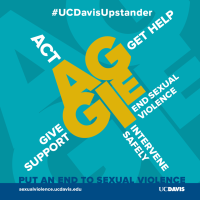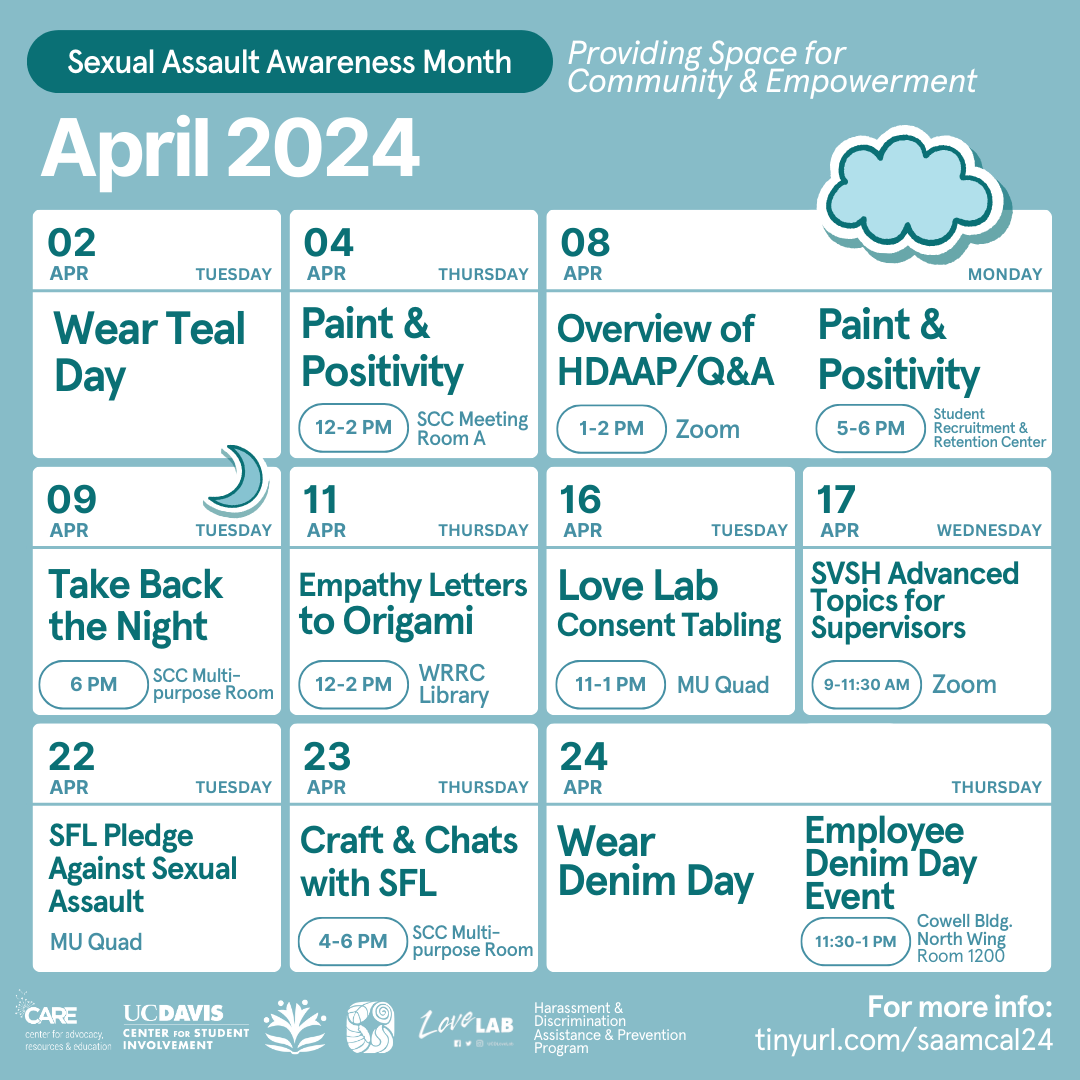
You may witness a situation that places someone in danger. Remember that you have the power to intervene and help someone.
When presented with a situation that looks like something isn’t quite right or that it requires your assistance, keep the following questions in mind:
- Could I play a role here?
- If no one intervenes, what will happen?
- What are my options?
- What are the risks?
- Is someone else better placed to respond? Who?
Speaking out against harmful speech is another way to engage in bystander intervention. Challenge statements that promote victim-blaming, rape culture, or sexism. By starting small and intentional, you can take one step closer toward ending sexual violence.
One common reason why people do not engage in bystander intervention stems from not knowing what to do. To overcome this challenge, it might be helpful to have a strategy in place so that you are better prepared to handle a situation if and when it comes up. To learn more about how to be an upstander and bystander intervention strategies, you may request a CARE program. Please see the "Request a Program" page for more information.
How to be involved all year long
There are many things we can do as individuals, groups, and society to keep sexual violence prevention and education as a key value and priority throughout the year! While our awareness and prevention months have an important history and bring much needed awareness and prevention efforts to the forefront; it is important that we are doing the work to be involved in sexual violence awareness and prevention all year long!
Some ways you can actively engage in awareness and prevention efforts throughout the year include:
- Believe and support survivors of sexual violence
- Speak out about sexual violence and learn ways to be an upstander
- Knowing and sharing information about organizations that do violence prevention work
- Getting involved as a volunteer or intern with programs doing violence prevention work
- Share what you know! Tell the people in your lives about awareness and prevention months and how they can get involved and make a difference
- Learning more through ongoing educational opportunities
- CARE provides free educational opportunities, learn more here!
- Stalking Awareness and Prevention Month
- Stalking Awareness and Prevention Month is January and was started in 2004 by the National Center for Victims of Crime. The aim was to increase the public’s interpretation of the crime of stalking. National Stalking Awareness Month (NSAM) us the time when we come together to raise awareness about the harmful impact of stalking on survivors and the larger community. It is also an important opportunity to center the voices of survivors and strengthen our collective commitment to improve prevention efforts and increase access to safety, justice, and healing for survivors of stalking.
UC Davis and the Center for Advocacy, Resources, and Education (CARE) work every day to uplift survivors. During January we also put on events, run social media campaigns to spread awareness, hand out awareness ribbons, and put on educational programming around the issue of stalking. Additionally, we encourage all of campus to wear yellow in the month of January to show support for survivors of Stalking. - Teen Dating Violence Awareness and Prevention Month
-
In 2005 the importance of addressing teen dating violence was highlighted in the reauthorization of the Violence Against Women Act. The following year, Congress followed the lead of dozens of national, state and local organizations in sounding the call to end dating abuse. Both Chambers declared the first full week in February “National Teen Dating Violence Prevention and Awareness Week (TDVAM)” Then in 2010, they began dedicating the entire month of February to teen dating violence awareness and prevention.
The intention of TDVAM is to bring advocates for awareness and prevention together from across the nation to bring attention to the issue of teen dating violence. By naming the violence that happens in teen dating relationships we can recognize it as harmful and begin the path to creating resources for survivors.
UC Davis and the Center for Advocacy, Resources, and Education (CARE) work every day to uplift survivors. During February we also put on events, run social media campaigns to spread awareness, hand out awareness ribbons, and put on educational programming around the issue of teen dating and domestic violence. Additionally, we encourage all of campus to wear purple for Wear Orange Day to show support for survivors of Teen Dating and Domestic Violence. - Sexual Assault Awareness and Prevention Month
-
During the 1980s, on the heels of the sexual violence awareness movement that began in the 1970s, the National Coalition Against Sexual Assault (NCASA) brought national agencies together to determine the dates for a National Sexual Assault Awareness Week. Over time, this week turned into a month and in April 2001, the first national Sexual Assault Awareness Month (SAAM) was recognized. SAAM is a campaign meant to give institutions, agencies, communities, and individuals a chance to raise awareness, empower and support sexual assault survivors, and collaborate on prevention efforts.
UC Davis and the Center for Advocacy, Resources, and Education (CARE) work every day to uplift survivors. During April we also put on events, run social media campaigns to spread awareness, hand out awareness ribbons, and put on educational programming around the issue of sexual assault. We also recognize, promote, and hold space for national awareness days such as Wear Teal Day, Denim Day, and Take Back the Night.
- Domestic Violence Awareness and Prevention Month
-
Domestic Violence Awareness Month (DVAM) evolved from the “Day of Unity” in October of 1981, originally observed by the National Coalition Against Domestic Violence. The intention of DVAM is to bring advocates for awareness and prevention together from across the nation to bring attention to the issue of domestic violence.
In October of 1987, the first Domestic Violence Awareness Month was observed, followed shortly by the congressional designation of October as the National Domestic Violence Awareness Month in 1989.
Intimate Partner Violence (IPV) refers to the patterns of abusive behaviors based on power and control within an intimate relationship. It is important to note that IPV occurs across age, ethnic, and socioeconomic lines, and all types of relationships.
UC Davis and the Center for Advocacy, Resources, and Education (CARE) work every day to uplift survivors. During October we also put on events, run social media campaigns to spread awareness, hand out awareness ribbons, and put on educational programming around the issue of domestic violence. Additionally, we encourage all of campus to wear purple for Wear Purple Day to show support for survivors of Domestic Violence.
